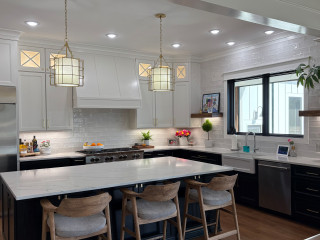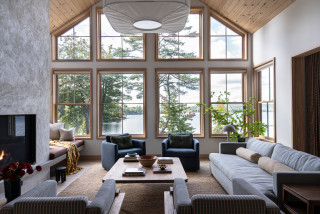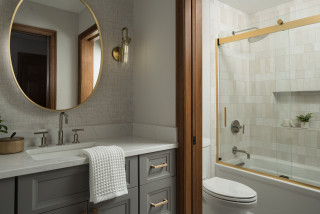
This article was originally published by a www.houzz.com . Read the Original article here. .

This article was originally published by a www.houzz.com . Read the Original article here. .

You can also write it down and store it in a document online. This can seem like a waste of time (you know what you want), but in the thick of getting your project done, there are many shiny objects that can stand between you and a successful remodel. Having your priorities written down will allow you to stand back in the heat of the moment and evaluate if a new option will get you closer to your goals or farther away.
In my experience about 60% to 70% of the choices that get made on the spur of the moment cost more than sticking to the original choice. Sometimes it’s because something needs to be redone or upgraded (like reinforcing a tile floor) that wasn’t taken into account during the design phase. And sometimes it’s just because a friend suggests that something seen on TV would look so good in your remodel. Whatever the case, if you have a list to refer to, it’s easier to evaluate if those changes will get you closer to your goals.
See why you should hire a professional who uses Houzz Pro software
This article was originally published by a www.houzz.com . Read the Original article here. .

Windsor recommends you anticipate issues that could be important to the homeowner early in the project. Her team does this by asking new clients how they found the experience of hiring renovation professionals in the past.
“This usually gives us a good understanding of what is most important to our client and how they might react when we hit the lowest part of the build,” she says.
For example, if the client complains that their builders were always late or didn’t inform them of everything, you will know that timekeeping and full communication are important to them.
For this, Windsor says she would put an action plan in place to ensure they have a platform where all information can be shared instantly and where everyone on site is aware.
Houzz Pro all-in-one business management software will help you do this, as you can set up a Client Dashboard to communicate quickly and clearly throughout the whole project. You can also share all those essential pieces of information easily, such as estimates, product specifications, floor plans, schedules and mood boards, so the client is kept in the picture all the way through.
Learn more about Houzz Pro software
This article was originally published by a www.houzz.com . Read the Original article here. .
The number of residential remodelers in the U.S. has reached a record high of 128,187 establishments, 65% higher than the number of residential builders (single-family and multifamily), which stands at 77,455. These official government counts were released by the U.S. Census Bureau as part of its 2022 Economic Census, which tallies American businesses every five years (in years ending in 2 and 7).
Growth in the number of remodelers significantly outpaced that of builders between 2017 and 2022. In that 5-year span, the remodeler count increased by 25% (102,818 to 128,187), while the number of builders grew at half that pace–by 12% (68,996 to 77,455).
A starker dichotomy emerges when comparing 2022 counts to those in 2007, prior to the financial crisis and the ensuing housing recession. In that 15-year period, the official number of residential remodelers in the U.S. grew by 73% (73,888 to 128,187), while the official number of residential builders contracted by 21% (98,067 to 77,455).
Another way to analyze this data is by creating a combined universe of both builders and remodelers and then calculating each group’s share of the total. In 2022, for example, remodelers represented 62% of the total number of builders and remodelers in the U.S, while builders made up a minority share of 38%. Remodelers have accounted for at least 60% of this total in the last three Economic Census (2012, 2017, and 2022).
The last time builders comprised a majority share was in 2007, when they represented 57% of the combined total number of builders and remodelers in the country.
Discover more from Eye On Housing
Subscribe to get the latest posts sent to your email.
This article was originally published by a eyeonhousing.org . Read the Original article here. .
In the second quarter of 2025, the NAHB/Westlake Royal Remodeling Market Index (RMI) posted a reading of 59, down four points compared to the previous quarter. While this reading is still in positive territory, some remodelers, especially in the West, are seeing a slowing of activity in their markets. The second-quarter reading of 59 marks only the second time the RMI has dipped below 60 since the survey was revised in the first quarter of 2020.
Higher interest rates and general economic uncertainty have affected consumer confidence and are headwinds for remodeling, but not to the extent that they have been for single-family construction, as is evident in June’s negative reading from the NAHB/Wells Fargo Housing Marketing Index (HMI). As a result, NAHB is still forecasting solid gains for remodeling spending in 2025, followed by more modest, but still positive, growth in 2026.
The RMI is based on a survey that asks remodelers to rate various aspects of the residential remodeling market “good”, “fair” or “poor.” Responses from each question are converted to an index that lies on a scale from 0 to 100. An index number above 50 indicates a higher proportion of respondents view conditions as good rather than poor.
Current Conditions
The Remodeling Market Index (RMI) is an average of two major component indices: the Current Conditions Index and the Future Indicators Index.
The Current Conditions Index is an average of three subcomponents: the current market for large remodeling projects ($50,000 or more), moderately sized projects ($20,000 to $49,999), and small projects (under $20,000). In the second quarter of 2025, the Current Conditions Index averaged 66, down five points from the previous quarter. All three components decreased quarter-over-quarter, with both small and moderately-sized remodeling projects falling six points to 70 and 66, respectively, while large remodeling projects slipped two points to 62. Nevertheless, all three components remained above 50 in positive territory.
Future Indicators
The Future Indicators Index is an average of two subcomponents: the current rate at which leads and inquiries are coming in, and the current backlog of remodeling projects.
In the second quarter of 2025, the Future Indicators Index averaged 51, decreasing four points from the previous quarter. While the component measuring the current rate at which leads and inquiries are coming in remained unchanged at 51, the component measuring the backlog of remodeling jobs fell six points to 52. Similar to the Current Conditions components, both remain above 50 in positive territory.
For the full set of RMI tables, including regional indices and a complete history for each RMI component, please visit NAHB’s RMI web page.
Discover more from Eye On Housing
Subscribe to get the latest posts sent to your email.
This article was originally published by a eyeonhousing.org . Read the Original article here. .

Good-quality accessories and hardware, such as pullout corner units, drawer dividers, and soft-close runners and door hinges, often get excluded from kitchen designs due to budget constraints. But this can be a false economy in the long run as features such as these can make a big difference to your kitchen, boosting its storage potential and making the space far more pleasant to use.
These features do add to the overall cost of a new kitchen, but they’re worth the extra outlay, particularly if you’re an enthusiastic cook.
Solution: Know your options. Ask your kitchen designer about all the storage and hardware options available so you can make a fully informed choice.
If you don’t specify exactly what you want, you may end up with less than ideal hardware and storage solutions, which can be a missed opportunity — think a setup that consists of more cupboards than drawers, drawers without inserts and no soft-closing hardware. If budget is a concern, focus on those features that you feel will make the most difference to your experience of the kitchen.
Shop for cabinet and drawer hardware on Houzz
This article was originally published by a www.houzz.com . Read the Original article here. .

A good estimate on the total cost, properly divided into each stage, is imperative for this plan to work.
If your plan is simple and includes new appliances, new paint and some new hardware, then the estimate will be easy. Go to an appliance store or go online and price out the appliances. Get that painting bid for your cabinets and walls. Count up the hardware requirements, price out your selection, and there you have it. Three simple stages and not much risk (as long as you confirm your appliance selections fit their respective spaces — more on that later).
In larger, more complex jobs, though, it’s difficult to properly price things out without some experience, as kitchen remodels can potentially involve framers, finish carpenters, drywallers, electricians, plumbers, tile setters, slab fabricators, painters and possibly even foundation contractors, roofers, insulators and more.
The point is that it can be challenging to properly estimate a phased remodel, or any remodel, but you need to have a go at it and keep refining and updating as needed. Contractors are experienced at the task, but if you are estimating on your own, make sure you get bids for every subcontractor task and price out the fixtures and materials. And, if you can, try to get some consultation from someone with experience.
This article was originally published by a www.houzz.com . Read the Original article here. .
Only 56% of professional remodelers undertake projects designed to allow homeowners to Age-in-Place (AIP), according to results from NAHB’s Q1 2025 Remodeling Market Index (RMI) survey. This is the lowest percentage recorded since NAHB began periodically asking AIP questions on its RMI survey in 2004. Economic uncertainty and high interest rates over the past year are the most likely explanations for this slight pullback in projects. Additionally, stock market volatility has dampened any potential wealth effects, especially since over 75% of all corporate equities and mutual fund holdings are held by those 55 or older.
The National Institute of Aging defines AIP as “staying in your own home as you get older.” This concept is becoming more relevant as the overall median age of the population continues to increase. Given the age of the existing housing stock, the need to update homes for AIP is a major demand-driver for the remodeling sector.
Age Groups
When asked about the age groups of homeowners who request AIP work, 73% of remodelers indicated that homeowners are 65 years or older, followed by 55 to 64 years at 61%. These two age groups have consistently been above 60% since the Q4 2010 survey.
Familiarity with Aging-in-Place
Ninety-six percent of remodelers indicated that most or some of their consumers are familiar with the AIP concept. That share has been at least 90% since the Q4 2018 survey.
Type of Aging-in-Place Projects
Grab bars remain the most common AIP project, with 87% of remodelers reporting this job in the last year, followed by curb-less shower (78%), installing higher toilets (71%), and widening doorways (52%). While their relative ranking has changed, these four have consistently been the AIP project types most often cited by remodelers.
Frequency of Aging-in-Place Requests
Seventy-three percent of remodelers indicated that requests for AIP features have significantly or somewhat increased over the past 5 years. This figure has not changed much since the inception of the series in 2004, ranging from 72% to 77%.
Reasons for Aging-in-Place Work
As for the reason why customers are undertaking AIP projects, 91% of remodelers stated that customers are planning ahead for future needs, followed by living with older parents (48%) and acute age-related disabilities (43%).
Who is Requesting Aging-in-Place Work?
Sixty-five percent of remodelers indicated that a majority of their AIP work was determined by the client, whereas the other 35% said it was mostly suggested by the contractor. The ‘determined by client’ option has consistently been above 50 percent.
Receptive to Aging-in-Place Modifications
When asked how receptive potential clients are to incorporating suggested AIP modifications, 48% indicated that their customers were very receptive and 51% were somewhat receptive, with only 2% stated that customers were not at all receptive to these modifications. The combined share of potential clients being receptive (‘very receptive’ + ‘somewhat receptive’) has consistently been above 95%.
Discover more from Eye On Housing
Subscribe to get the latest posts sent to your email.
This article was originally published by a eyeonhousing.org . Read the Original article here. .

Renovating homeowners invested in products with both standard and smart technology in 2024, and in fact preferred smart tech in several product categories. The dark green bars in this graphic represent standard products. The light green shows smart products, which refers to technology that can be monitored or controlled from a mobile device (smartphone or tablet), a computer or both.
Light fixtures topped the list of indoor product purchases at 51%, with 38% of renovating homeowners choosing standard and 13% opting for smart versions. TVs followed at 27%, with 16% choosing standard TVs and 11% opting for smart.
Alarms and detectors (14% standard, 12% smart) and thermostats (7% standard, 16% smart) also were in demand. Smart versions led for wireless doorbell cameras (16%), streaming-media players (10%), home assistants (14%) and garage door openers (8%) as well. And among smart security products, homeowners chose wireless door locks (8%), cameras (9%) and motion or other sensors (5%).
Smart security cameras led outdoor tech purchases at 23%, followed by standard outdoor lighting fixtures at 23% (not shown).
10 Ways to Control the Cost of Your Bathroom Remodel
This article was originally published by a www.houzz.com . Read the Original article here. .
In a previous post, NAHB analyzed where builders and remodelers purchased products, regardless of who ultimately purchases them (themselves or subcontractors). In this post, the question shifts to who is most often responsible for the choice of particular products.
When averaging over all 24 building product categories, 60% of builders report they had the most influence on product selection compared to 49% of remodelers. Still, these shares are ranked the highest within their respective sector. Both builders and remodelers reported similar shares of influence for subcontractors, dealers & suppliers, and architects.
However, when it comes to the greatest influencer being the customer, this is more prevalent among remodelers (26%) than among builders (16%). When analyzing the top seven products most often chosen by the customer, there is a considerable gap between remodelers and builders. Most of these products (cabinets, lighting, carpeting, ceramic tile, countertops, other flooring) typically are chosen for decorative qualities which are rated quite important among customers.
Please click here to be redirected to the full report.
Discover more from Eye On Housing
Subscribe to get the latest posts sent to your email.
This article was originally published by a eyeonhousing.org . Read the Original article here. .
In your contractor’s mind, these four words translate to “change order.” And while change orders are necessary and inevitable in many cases, they are notorious for adding cost to a project. If you’ve worked hard to come to an agreement with your banker, your contractor or your spouse to stay within a fixed price, a change order or two (or three, or 10) can throw your budget a curveball.
The moral of the story is to be aware of what you ask your contractor to do. Moving a can light involves more than an electrician. The drywall contractor and painter will need to patch the hole where the light was previously, for example. Altogether, it could end up costing hundreds to move that light half a foot. That might be pocket change to some people. But throw in seven to 10 more “pocket change”-sized change orders, and suddenly your bill has increased by a couple thousand dollars.
To prevent change orders, try to think carefully about everything involved (paint colors, position of can lights) in your project before the start date to make sure they’re included in your scope of work and contract. It will more than likely save you a few bucks — and a few headaches.
There is, of course, a chance that the professional you hired will move that can light for free. Every project and every professional is different. But odds are there are service fees (and a markup on those service fees) involved, so be aware of the implications of “while you’re at it.”
New to home remodeling? Learn the basics